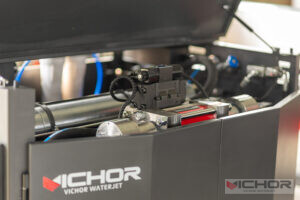
Hydro Abrasive Cutting: How Water Jets Slice Through Virtually Anything
In the world of modern manufacturing and fabrication, the need for precise, versatile, and cold cutting processes is paramount. Among the array of technologies available, one stands out for its unique ability to combine immense power with delicate precision: hydro abrasive cutting. Often referred to as abrasive waterjet cutting, this technology has revolutionized how industries work with materials that are sensitive to heat or exceptionally hard. But what exactly is it, how does it work, and where does it excel? This article delves deep into the science, benefits, and practical considerations of hydro abrasive cutting.
What is Hydro Abrasive Cutting? The Basic Principle
At its core, hydro abrasive cutting is a cold-cutting process that uses a high-velocity stream of water mixed with a granular abrasive substance to erode material. Think of it as a highly controlled, super-powered version of river erosion, where water and sand gradually wear down rock, but accelerated to an incredible speed and precision.
The process begins with a high-pressure pump that intensifies ordinary water to extreme pressures, often exceeding 60,000 PSI (4,000 bar). This ultra-high-pressure water is then focused through a small orifice, typically made of sapphire or diamond, creating a very fine, supersonic stream of pure water. For cutting softer materials like foam, rubber, or food products, this pure waterjet is sufficient. However, to slice through metals, stone, ceramics, and composites, an abrasive is introduced into the stream. This is where the “abrasive” in hydro abrasive cutting comes into play. A granular abrasive, usually garnet, is sucked into a mixing chamber and combined with the high-speed water jet. This mixture exits through a focusing tube (or nozzle), creating a coherent, erosive stream capable of cutting through virtually any material known to man.
The Key Advantages of Using Hydro Abrasive Cutting
The popularity of hydro abrasive cutting is not without reason. It offers a set of distinct advantages that make it the preferred choice for countless applications.
No Heat-Affected Zone (HAZ): Unlike laser or plasma cutting, which generate intense heat, hydro abrasive cutting is a cold process. The water cools the material as it cuts, eliminating the risk of altering the material’s metallurgical properties, hardening the edges, or creating thermal stress and distortion. This is critical for materials like tool steel, titanium, and heat-treated alloys.
Omnidirectional Cutting and No Tool Wear: The abrasive waterjet stream can move in any direction, allowing for extreme flexibility in cutting complex shapes, sharp corners, and intricate details without the need for tool changes. There is no physical cutting tool that wears out, only the consumable orifice and nozzle.
Ability to Cut Virtually Any Material: This is perhaps its most significant advantage. From soft and delicate materials like foam and rubber to incredibly hard substances like granite, armor plate, and advanced composites, hydro abrasive cutting handles them all. It can even cut layered materials, like carbon fiber sandwiched between aluminum, with ease.
High Precision and Minimal Kerf: The cutting stream is very narrow, typically between 0.020″ to 0.050″ (0.5mm to 1.3mm), resulting in a small “kerf” (the width of the cut). This minimizes material waste and allows for tight nesting of parts, optimizing material usage.
Environmentally Friendly: The process produces no hazardous fumes or gases. The primary waste is a slurry of water and spent abrasive, which can often be recycled and managed responsibly.
Common Applications Across Industries
The versatility of hydro abrasive cutting has led to its adoption across a wide spectrum of industries.
Aerospace and Defense: Used for cutting heat-sensitive titanium alloys, aluminum components, and advanced composites used in aircraft frames and military armor.
Architecture and Art: Ideal for creating intricate designs in stone, marble, glass, and metal for countertops, sculptures, and decorative panels.
Automotive: Employed for cutting interior materials (like carpets and gaskets), composite body panels, and custom parts without affecting their structural integrity.
Machine and Tool Shops: Perfect for prototyping and producing precise parts from a wide range of materials without inducing heat stress.
The Hydro Abrasive Cutting System: Core Components
Understanding the technology requires a look at its key components:
High-Pressure Pump: The heart of the system. It can be an intensifier pump (using hydraulic pressure to intensify water pressure) or a direct-drive pump (using a crankshaft). Intensifier pumps are more common for high-power industrial applications.
Abrasive Delivery System: This includes a hopper that holds the abrasive (like garnet) and a device that accurately meters and feeds the abrasive into the mixing chamber.
Cutting Head: This is where the magic happens. It contains the Orifice (creates the pure waterjet), the Mixing Chamber (where water and abrasive combine), and the Focusing Tube/Nozzle (shapes and accelerates the abrasive jet).
CNC Motion System: A computer-controlled (CNC) gantry or robot arm that moves the cutting head with high precision along the programmed cutting path.
Catcher Tank: A large tank located beneath the material that catches the high-energy stream after it has passed through the workpiece. It absorbs the energy and contains the water-abrasive slurry.
Addressing Common Questions and Challenges in Hydro Abrasive Cutting
While a powerful technology, hydro abrasive cutting is not without its challenges and common questions.
1. What is the “taper” issue and how is it corrected?
One of the most common characteristics of a hydro abrasive cutting stream is that it loses energy as it travels through the material. This can result in a slightly wider cut at the top of the material than at the bottom, known as taper. Modern CNC systems employ “taper compensation” techniques, where the cutting head is tilted at a slight angle or the cutting path is dynamically adjusted to produce parts with perfectly vertical edges.
2. How fast and accurate is the cutting process?
The cutting speed depends on the material type, thickness, and desired finish quality. While it is generally slower than plasma cutting for thin metals, it is often faster than wire EDM for thicker materials. Accuracy is exceptionally high, typically within ±0.005″ (±0.13mm), making it suitable for precision parts.
3. What about operating costs and consumables?
The primary operational costs are electricity, the abrasive garnet (a consumable), and the replacement of wear parts like the orifice and focusing tube. While abrasive cost is a significant factor, the ability to cut expensive materials with minimal waste and no heat damage often justifies the expense.
4. Can it cut thick materials effectively?
Yes, hydro abrasive cutting is renowned for its ability to cut very thick materials (up to 12 inches or more) that would be challenging or impossible for other technologies. However, cutting speed decreases significantly as thickness increases, and maintaining precision requires careful control of the stream.
5. How is the cut edge quality?
The cut edge has a matte, satin finish. There is typically a slight “striation” pattern (wavy lines) on the edge, which is a signature of the process. The quality can be adjusted; a faster cut produces a rougher finish, while a slower, more precise cut yields a smoother edge. For many applications, the edge is acceptable as-is, but it can be polished if a smoother finish is required.
Hydro abrasive cutting has firmly established itself as an indispensable tool in the manufacturing landscape. Its unique combination of cold-cutting capability, material versatility, and high precision solves problems that other technologies cannot. By understanding its principles, advantages, and how to address its common challenges, manufacturers and artists alike can leverage the full power of water to turn their most ambitious projects into reality. As the technology continues to evolve with improvements in pump efficiency, nozzle design, and control software, the applications for hydro abrasive cutting are set to expand even further.
continue reading
Related Posts
- 1371 words6.9 min read
- 1449 words7.3 min read



